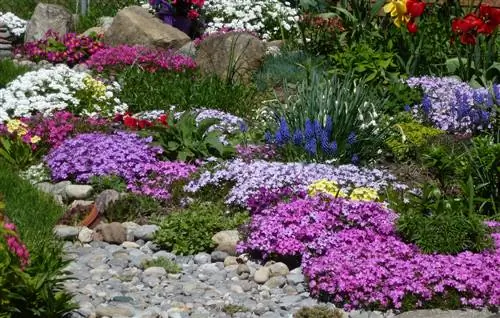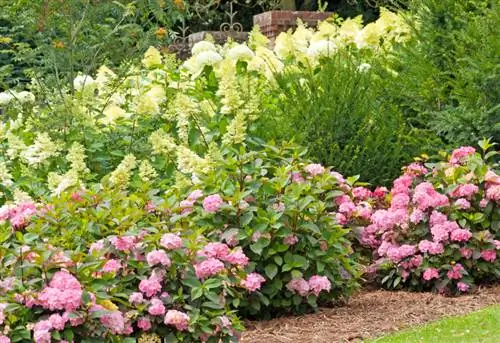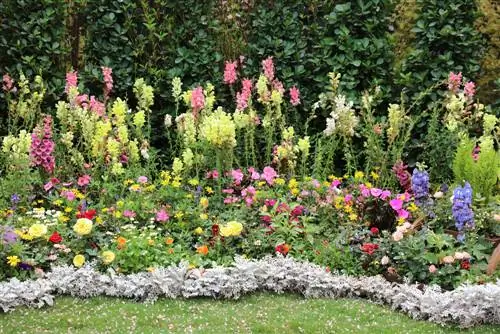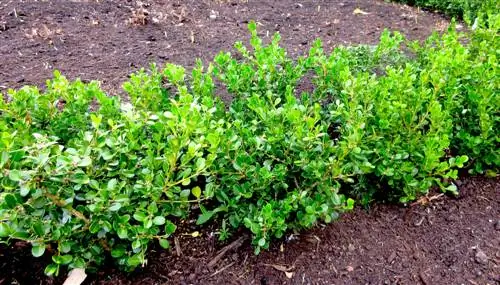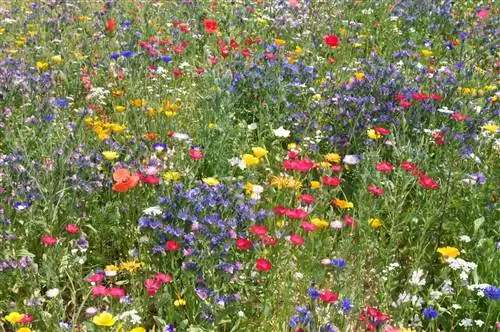- Author admin [email protected].
- Public 2024-01-05 20:48.
- Last modified 2025-01-23 11:22.
Perennial beds don't have to be created every year because the plants sprout again on their own in spring. This makes it all the more important to plan the perennial bed correctly. Here you will find a selection of the most beautiful perennials as well as great ideas and instructions on how to create an attractive perennial bed step by step.
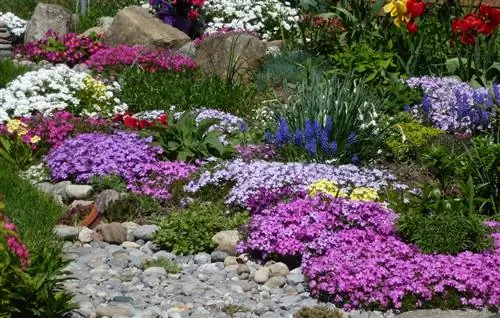
How do I create a perennial bed?
To create a perennial bed, first plan the plant selection and positioning. Then prepare the soil and plant the perennials. Add decorative elements, cover the soil and place a bed border.
What are perennials?
Perennials are perennial, non-woody plants that overwinter in the ground with the help of rhizomes, tubers or bulbs and sprout again in spring. They can be cultivated in beds or in pots, although as potted plants they may need winter protection because the roots are exposed to more cold. Perennials are not always flowers. There are also vegetables, climbing plants, ferns, rose plants and even pond plants that are perennials. The height of growth varies greatly, even if they rarely grow higher than one meter because, as mentioned, perennials are not woody. In winter the outer leaf parts usually die off, even if there are some wintergreen perennials.
The most beautiful perennials for your perennial bed
When selecting perennials for your perennial bed, you should not only consider aesthetic aspects such as flower color and height of growth, you should pay particular attention to the location requirements of the perennials. Not all perennials thrive in bright midday sun. If you plant shade-loving perennials in the sun, you will only get a few flowers. Only those who take the location requirements of their plants into account will be able to enjoy lush flowers. Most perennials are available in different colors, often in different growth forms, i.e. as carpet plants or tall-growing perennials such as the astilbe or the Bluebell. The most important perennial families are:
- Lavender
- Aster
- Bellflower
- Storksbill
- Anemone
- Thyme
- Astilbe
- Honorary Award
- nettles
- Sage
- Coneflower
- Funkia
- Phlox
- Peony
- Carnations
- Lilies
- larkspur
- Yarrow
- Houseleek
- Mint and peppermint
- Sedum species
- ornamental onion
- Blue pillow
- Veronika
The most beautiful design ideas for the perennial bed
There are many different aspects to consider when designing a perennial bed. Here are a few ideas about what you should think about when planning:
- The bed border: A perennial bed should be separated from the garden with stones, wood or border plants.
- The height of the perennials: Taller perennials should be planted in the middle, small perennials and ground cover plants should be planted at the edge.
- Decorative elements: Large stones, decorative plant pots, water elements or even antique devices such as wheelbarrows or similar can turn a perennial bed into an extraordinary garden spectacle.
You can find out more about planning your perennial bed here.
Color combinations for the perennial bed
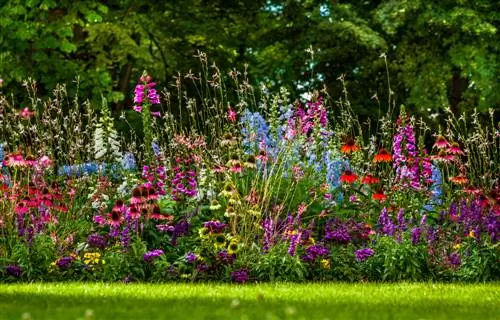
Some gardeners like it colorful
When it comes to the color design of perennial beds, tastes differ: Some people like it colorful, others like it sunny yellow and others like it elegant white. For example, color combinations such as blue-white or violet-white or red, orange and yellow look particularly beautiful. When making your selection, also pay attention to the flowering time. Do you want all the perennials to bloom at the same time and transform your perennial bed into an impressive sea of flowers or do you prefer that something blooms all year round?
Perennials with purple or pink flowers
- Balkan Cranesbill
- Blue cushion 'Blue Tit'
- Blood Cranesbill
- True thyme
- Autumn Anemone 'Rose Bowl'
- Hedgehog butt leek
- Carnation Carnation
- Moroccan Mint
- Peony 'Sarah Bernhard'
- Splendid Cranesbill 'Vital'
- Sage 'Caradonna'
- Coneflower 'Magnus'
- Star ball garlic
- Carpet bellflower 'Birch'
- carpet spars
- Thyme 'Coccineus'
- many types of lavender
- Dwarf Hosta
- Dwarf Cranesbill 'Ballerina'
Perennials with white flowers
Example perennials with white flowers:
- Aster ‘Snow Flurry’
- Balcony Cranesbill 'White-Ness'
- Blue cushion 'Fiona'
- Blue cushion 'Winterling'
- wood anemones
- China Anemone
- Honorary Award 'Schneeriesin'
- Stuffed Yarrow 'The Pearl'
- Heiden pink 'Albus'
- Autumn anemone 'Honorine Jobert'
- Lavender 'Hidcote White'
- Lavender ‘Nana Alba’
- Peppermint
- Peony 'Festiva Maxima'
- Sage 'Adrian'
- Coneflower 'Alba'
- Carpet phlox 'Maischnee'
- Thyme ‘Albus’
- Forest Danemone
- Forest bellflower 'Alba'
- White Blood Cranesbill 'Album'
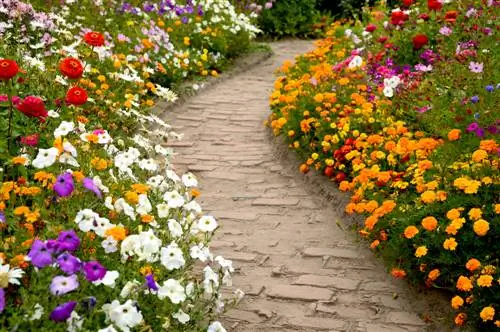
Yellow perennials create a warm, glowing garden bed
Perennials with yellow or orange flowers
- Columbine 'Yellow Queen'
- Fat leaf 'Weihenstephaner Gold'
- Yellow cowslip
- Yellow Coneflower
- Gold Hair Aster
- stonecrop
- Sun Bride ‘W altraud’
- Coneflower 'Tiki Torch'
- Daylily 'Stella de Oro'
- Carpet Yarrow 'Aurea'
- Tibetan bell primrose
- Tripmadame
- many types of girls' eyes
- Water Iris
- Winter aster ‘Citronella’
Create a perennial bed step by step
1. Planning
Before you get to work, you should plan the perennial bed. To do this, measure your perennial bed and draw a rough sketch. Think about which flower color(s) should dominate and look at perennials online or in garden shops. Write down the names and flower color of the ones you like and then arrange them on your sketch. When arranging them, consider the height of the individual plants. Pay attention to the planting distance! Once you've placed your plants on paper, you'll have a better idea of how many perennials you'll need. Also plan space for any decorative elements.
2. Staking and preparing soil
Then stake out the perennial bed in your garden. Dig the soil thoroughly and remove roots, stones and weeds. If the soil is poor, it may make sense to dig some compost underground.
3. Planting perennials
Now plant your perennials. Work your way from the inside out. Finally, water your plants.
4. Set decorative elements
Now it's time to place your decorative elements. If you have made a mistake with the space, it is still possible to move individual plants and reorganize them. To protect against drying out and weeds for a more beautiful look, you can finally cover the soil with mulch, pebbles or similar.
5. Bed border
Last but not least, the bed border is placed, which visually demarcates your perennial bed and prevents ground cover, for example, from spreading onto the lawn.

